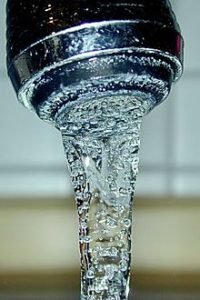
I think about water a lot . . . the pollution of water, people who don’t have access to clean water, the controlling and re-channeling of water, and acid rain. I love water and grew up drinking Glenn Springs mineral water. You don’t hear of that today. Work together to see that our water supply is clean by not pouring medicines into it or putting poisons and toxins in it. It will all come back to us. We are water!
SAFE DRINKING WATER
There is evidence that the United States federal drinking water regulations do not ensure safe water, as some of the regulations have not been updated with more recent science. Dr. Peter W. Preuss, who became the head of the U.S. EPA’s division analyzing environmental risks in 2004, has been “particularly concerned”, and has faced controversy in studies which suggest that regulations against certain chemicals should be tightened.
In 2010 the EPA showed that 54 active pharmaceutical ingredients and 10 metabolites had been found in treated drinking water. An earlier study from 2005 by the EPA and the Geographical Survey states that 40% of water was contaminated with nonprescription pharmaceuticals, and it has been reported that of the 8 of the 12 most commonly occurring chemicals in drinking water are estrogenic hormones. Of the pharmaceutical components found in drinking water, the EPA only regulates lindane and perchlorate. In 2009, the EPA did announce another 13 chemicals, hormones, and antibiotics that could potentially be regulated. The decision on whether or not they are sufficiently harmful to be regulated may not be decided upon until 2012 as it takes time for testing.
Common Contaminants in Drinking Water:
Chlorine: Drinking water owes its safety largely to the addition of chlorine, which is used to kill the disease-causing bacteria and viruses found in untreated water. It also reacts with naturally occurring materials in water to form disinfection byproducts. Prolonged exposure to these byproducts increases your risk of liver damage and cancer.
Flouride: In many areas, it is added to drinking water to promote dental health. Research has shown that prolonged exposure to excess flouride (more than the standard level of 4mg/L) may result in bone disease. For children under age nine, whose teeth are still developing, the EPA flouride standard is 2 mg/L.
Lead: Between the water treatment plant and your faucet, water may pass through corroded plumbing that can cause lead to leach into it. Children and pregnant women are most susceptible to lead-related health risks such as neurological damage, kidney and liver problems, and developmental delays in children.
Radon: Although regulated by public water utilities, radon may accumulate in underground water sources, a concern for those on private wells. Exposure to radon in drinking water and by inhaling the gas as it is released from the water during showers, washing, and laundering increases your cancer risk.
Volatile Organic Compounds: VOC’s are commonly found in fuels, solvents, cosmetics, drugs, and dry cleaning solutions. They get into drinking water through improper industrial discharges that seep into ground water, a concern to those with wells. Health effects vary from eye, respiratory, and skin irritation to risk of cancer depending on the VOC and length of exposure.
Pharmaceuticals: Increasingly, these compounds are appearing in trace amounts in drinking water and are currently under study by the EPA to assess the long-term side effects as well as what treatment options may remove them from water supplies.
Nitrates: Run-off and improper disposal of synthetic fertilizers dump nitrates into the water system. They pose immediate threats to newborns because they interfere with the oxygen-carrying capacity of the child’s blood.
The EPA provides a comprehensive list of commonly found contaminants and evaluates water supplies for many major cities. Access this information and more at www.epa.gov/safewater. If you have specific questions related to water quality, you can also contact The Safe Drinking Water Hotline at 800.426.4791 for assistance.
Home Protection
You can make your drinking water purer with a home filtration system. Your options include “point of entry” filters that treat water as it enters your home and “point of use” filters that treat water right before you drink it.
- Carbon Filter:
Removes: Chlorine, disinfection byproducts, pesticides, radon. Reduces heavy metals including copper, lead and mercury. Be certain to check model as all carbon filters do not perform the same filtration benefits. Style Options: Countertop Pitchers, faucet filters and under-the-sink units. Advantages: Generally low in cost and they retain minerals in water, which are beneficial to health.
- Distillation:
Removes: Bacteria and heavy metals such as cadmium, chromium, copper, lead and mercury, as well as arsenic, barium, flouride, selenium, and sodium.
Style Options: Countertop or whole house point-of-entry units; can be combined with a carbon filter. Without a carbon filter addition, they do not remove chlorine, chlorine byproducts or VOCs. The process removes all minerals, leaving behind acidic water.
- Reverse Osmosis:
Removes: Most disease-causing bacteria, flouride, nitrates, asbestos, metals including lead.
Style Options: Under the counter point-of-use
Drawbacks: Without carbon filter, RO filters do not remove VOCs or chlorine. Removes all minerals resulting in acidic water.
Clean Water Practices
Use organic fertilizers on lawns.
Dispose of chemicals properly
Use organic pest control
Stop using plastic
Pick up plastics on shorelines
Plant native plants that are less thirsty for water
Install rain barrels for watering plants
Wash the car with a bucket and soap, not a hose
Leave grass clippings on lawns
Use a brush to sweep driveways, not a hose
Use non-toxic cleaning products so toxins don’t go into our water supply or soil.
Turn prescription drugs in on collection dates so they don’t enter our water.

